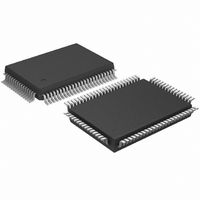SAA7706H/N210,518 NXP Semiconductors, SAA7706H/N210,518 Datasheet - Page 21

SAA7706H/N210,518
Manufacturer Part Number
SAA7706H/N210,518
Description
IC CAR RADIO DSP 80-QFP
Manufacturer
NXP Semiconductors
Type
Car Signal Processorr
Datasheet
1.SAA7706HN210S518.pdf
(52 pages)
Specifications of SAA7706H/N210,518
Interface
I²C, I²S, LSB, SPDIF
Voltage - I/o
3.30V
Voltage - Core
3.30V
Operating Temperature
-40°C ~ 85°C
Mounting Type
Surface Mount
Package / Case
80-QFP
Lead Free Status / RoHS Status
Lead free / RoHS Compliant
Clock Rate
-
Non-volatile Memory
-
On-chip Ram
-
Other names
935270285518
SAA7706H/N210-T
SAA7706H/N210-T
SAA7706H/N210-T
SAA7706H/N210-T
Available stocks
Company
Part Number
Manufacturer
Quantity
Price
Company:
Part Number:
SAA7706H/N210,518
Manufacturer:
NXP Semiconductors
Quantity:
10 000
Philips Semiconductors
8.5
In radio mode the stereo decoder, the ADC3 and RDS
demodulator, the ADC1 or ADC2 and the level decimation
filters have to run synchronously to the 19 kHz pilot.
Therefore a clock signal with a controlled frequency of a
multiple of 19 kHz (9.728 MHz = 512
In the SAA7706H the patented method of non-equidistant
digitally controlled sampling DCS clock has been
implemented. By a special dividing mechanism a
frequency of 9.728 MHz from the PLL2 clock frequency of
>40 MHz is generated. The dividing can be changed by
means of I
frequencies of the DCS block.
The DCS system is controlled by up or down information
from the stereo decoder. In the event of mono
transmissions or 44.1 kHz ADC1 or ADC2 usage the DCS
clock is still controlled by the stereo decoder loop. The
output keeps the DCS free running on a multiple frequency
of 19 kHz 2 Hz if the correct clock setting is applied. In
tape/cd of either 38 or 44.1 kHz and AM mode the DCS
clock always has to be put in preset mode with a bit in the
I
8.6
8.6.1
The IAC detects and suppresses ignition interference. This
hardware IAC is a modified, digitized and extended
version of the analog circuit which is in use for many years
already.
The IAC consists of an MPX mute function switched by
mute pulses from ignition interference pulse detectors.
The input signal of a second IAC detection circuit is the
FM level signal (the output of the level-ADC). This detector
performs optimally in lower antenna voltage
circumstances. It is therefore complementary to the first
detector.
The input signal of a first IAC detection circuit is the output
signal of one of the down-sample paths coming from ADC1
or ADC2. This interference detector analyses the
high-frequency contents of the MPX signal. The
discrimination between interference pulses and other
signals is performed by a special Philips patented fuzzy
logic such as algorithm and is based on probability
calculations. This detector performs optimally in higher
antenna voltage circumstances. On detection of ignition
interference, this logic will send appropriate pulses to the
MPX mute switch.
2001 Mar 05
2
C-bus memory map definitions.
Car radio Digital Signal Processor (DSP)
DCS clock
The Interference Absorption Circuit (IAC)
G
2
ENERAL DESCRIPTION
C-bus bits to cope with the different input
19 kHz) is needed.
21
The characteristics of both IAC detectors can be adapted
to the properties of different FM front-ends by means of the
predefined coefficients in the IAC control registers. The
values can be changed via the I
can be switched on or off independently of each other.
Both IAC detectors can mute the MPX signal
independently of each other.
A third IAC function is the dynamic IAC circuit. This block
is intended to switch off the IAC completely the moment
the MPX signal has a too high frequency deviation which
in the event of small IF filters can result in AM modulation.
This AM modulation could be interpreted by the IAC
circuitry as interference caused by the car’s engine.
8.7
The FSDAC is a semi-digital reconstruction filter that
converts the 1-bit data stream of the noise shaper to an
analog output voltage. The filter coefficients are
implemented as current sources and are summed at
virtual ground of the output operational amplifier. In this
way very high signal-to-noise performance and low clock
jitter sensitivity is achieved. A post-filter is not needed due
to the inherent filter function of the DAC. On-board
amplifiers convert the FSDAC output current to an output
voltage signal capable of driving a line output.
The output voltage of the FSDAC scales proportionally
with the power supply voltage.
8.7.1
The digital filter interpolates from 1 to 64f
cascade of a recursive filter and an FIR filter.
Table 2 Digital interpolation filter characteristics
8.7.2
The 5th-order noise shaper operates at 64f
in-band quantization noise to frequencies well above the
audio band. This noise shaping technique enables high
signal-to-noise ratios to be achieved. The noise shaper
output is converted into an analog signal using a filter
stream digital-to-analog converter.
Pass band ripple
Stop band
Dynamic range
Gain
The Filter Stream DAC (FSDAC)
I
N
ITEM
NTERPOLATION FILTER
OISE SHAPER
0
>0.55f
0
DC
CONDITIONS
0.45f
0.45f
2
s
C-bus. Both IAC detectors
s
s
Product specification
SAA7706H
s
116.5
by means of a
s
VALUE (dB)
0.03
50
3.5
. It shifts













